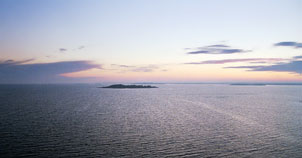Oxygen depletion in deep basins
 Oxygen depletion in the deep basins of the Baltic Sea is a natural problem due to limited water exchange between the Baltic and North Seas, the large input of freshwater run-off into the Baltic Sea and salinity differences preventing deeper waters from mixing with oxygen-rich surface waters. However, eutrophication induced by excessive nutrient input has considerably worsened this oxygen depletion, further threatening marine ecosystems, biodiversity and fish stocks.
Oxygen depletion in the deep basins of the Baltic Sea is a natural problem due to limited water exchange between the Baltic and North Seas, the large input of freshwater run-off into the Baltic Sea and salinity differences preventing deeper waters from mixing with oxygen-rich surface waters. However, eutrophication induced by excessive nutrient input has considerably worsened this oxygen depletion, further threatening marine ecosystems, biodiversity and fish stocks.
Oxygen depletion is widely used as an indicator for the indirect effects of nutrient enrichment. While oxygen levels above 4.5 ml/l are considered to cause no problems for macroscopic animals, levels below this cause increasing stress to most organisms. Lowest oxygen levels are experienced at the end of summer, between August and October, when detritus from biological activity in the surface waters has sunk, and is decomposed by bacteria. This process consumes oxygen. When oxygen concentrations fall below about 1 ml/l, bacteria start to use anaerobic processes, producing hydrogen sulphide. Hydrogen sulphide is toxic, and its concentration is described in terms of negative oxygen.
For more information see the HELCOM Indicator Fact Sheet on hydrography and oxygen in deep basins.
Inflow of water from the North Sea brings oxygen to the Baltic Sea
The inflow of water from the North Sea represents a lifeline for Baltic ecosystems. A small inflow of water at and below the halocline feeds saltwater into the Baltic more or less continuously. But the more massive "pulses" of oxygen-rich saltwater, which are so vital in maintaining oxygen levels in deep waters, are regulated by weather conditions (air pressure and storms).
These major inflows from the North Sea are also affected by levels of precipitation in the catchment area, and the subsequent volume of fresh water entering the Baltic Sea from rivers, especially during the winter.
The exchange of water between the Baltic Sea and the North Sea has slowed in recent decades. This could be related to variations in the large-scale climatic conditions affecting the distribution of high and low pressure areas, winds and precipitation.
For more information see the HELCOM Indicator Fact Sheet on water exchange between the Baltic Sea and the North Sea and conditions in the deep basins.

